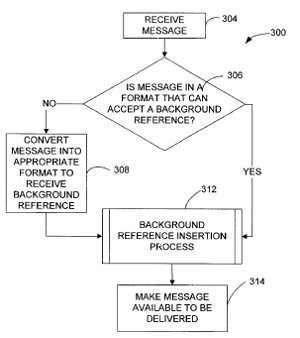 Creative Internet Adver. Corp. v. Yahoo!, Inc., 2010-1215 (Fed Cir. April 22, 2011) [PDF].
Creative Internet Adver. Corp. v. Yahoo!, Inc., 2010-1215 (Fed Cir. April 22, 2011) [PDF].
Creative sued Yahoo! claiming Yahoo!’s instant messaging product, Yahoo! Messenger infringed U.S. Patent No. 6,205,432. The ‘432 patent is directed to a system where references to advertisements are inserted between end users of an instant messaging software.
The claim at issue on appeal was claim 45, which provides:
45. A computer program embodied on a computer-readable medium for inserting a background reference to a stored advertisement into an end user
communication message, said computer program comprising:logic configured to receive an end user communication message from a first site;
logic configured to insert a background reference to a stored advertisement into said end user communication message, wherein said logic configured to insert the background reference is further configured to insert said background reference responsive to an overwrite authorization; and
logic configured to transmit said end user communication message with the background reference
to a second site.
Yahoo asserted that each logic elements of the claim must operate on the same message, e.g. one message being received, inserted into, and transmitted. Creative argued that all three logic elements did not need to operate on the same message.
Majority: Claim requires each logic step to act on same message(s). The majority agreed with Yahoo, at least in part. Generally the use of “an” or “a” in a claim means one or more. So the phrase “an end user communication message”, means one or more end user communication messages. The majority noted that “The subsequent use of definite articles “the” or “said” in a claim to refer back to the same claim term does not change the general plural rule [of “an”], but simply reinvokes that non-singular meaning.” The majority concluded that to infringe claim 45 the system must contain logic configured to insert a background reference into the same messages that are received and transmitted by other logic elements in the program. But, the insertion logic need not act on the message after it is received, it could act an other time. The court concluded that the trial court erred in failing to instruct the jury on this point.
Dissent: Apparatus claim requires no operation order nor action on the same message(s). The dissent asserted that because claim 45 was an apparatus claim, an infringing program only needed to have logic for receiving, inserting, and transmission, but the execution of that logic could be in any order. Further, the dissent found that the use of the term “said” in the claim does not require that each logic limitation be executed on the same message. The dissent asserted that the majority was interpreting the apparatus claim 45 as a method claim. The dissent stated, “requiring a concerted execution of the claimed logic upon a single message is not the proper test for infringement of an apparatus claim.” The dissent continued, “Instead, the proper question for infringement is whether the accused computer program contains logic configured to meet each limitation, regardless of how or when the claimed logic is used.”
The majority said that the dissent’s interpretation would cover a program that that only receives a message, inserts a background reference into a different message, and then transmits a third message. The majority asserted that this interpretation is contrary of the claim language because “it would render the word ‘said’ a nullity.”